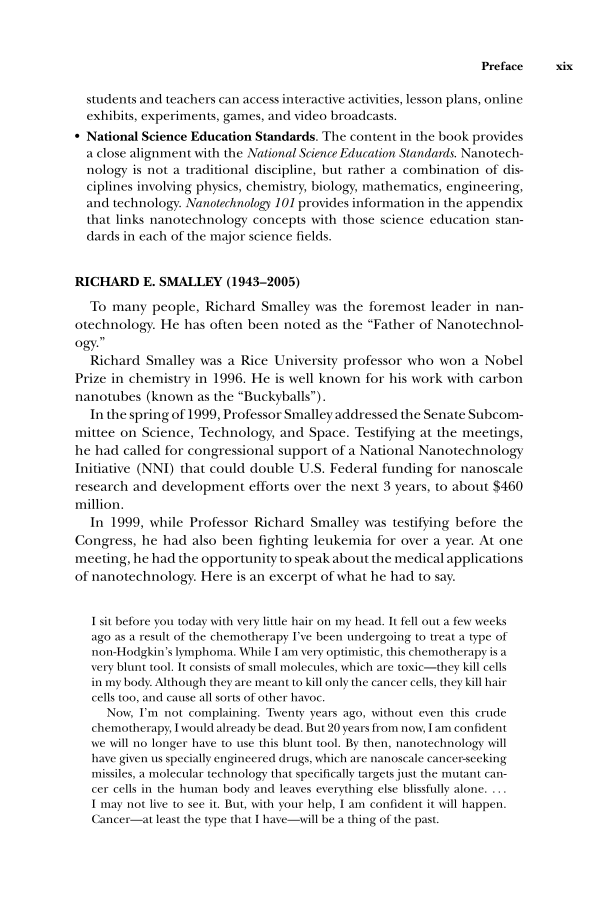Preface xix students and teachers can access interactive activities, lesson plans, online exhibits, experiments, games, and video broadcasts. National Science Education Standards. The content in the book provides a close alignment with the National Science Education Standards. Nanotech- nology is not a traditional discipline, but rather a combination of dis- ciplines involving physics, chemistry, biology, mathematics, engineering, and technology. Nanotechnology 101 provides information in the appendix that links nanotechnology concepts with those science education stan- dards in each of the major science fields. RICHARD E. SMALLEY (1943–2005) To many people, Richard Smalley was the foremost leader in nan- otechnology. He has often been noted as the “Father of Nanotechnol- ogy.” Richard Smalley was a Rice University professor who won a Nobel Prize in chemistry in 1996. He is well known for his work with carbon nanotubes (known as the “Buckyballs”). In the spring of 1999, Professor Smalley addressed the Senate Subcom- mittee on Science, Technology, and Space. Testifying at the meetings, he had called for congressional support of a National Nanotechnology Initiative (NNI) that could double U.S. Federal funding for nanoscale research and development efforts over the next 3 years, to about $460 million. In 1999, while Professor Richard Smalley was testifying before the Congress, he had also been fighting leukemia for over a year. At one meeting, he had the opportunity to speak about the medical applications of nanotechnology. Here is an excerpt of what he had to say. I sit before you today with very little hair on my head. It fell out a few weeks ago as a result of the chemotherapy I’ve been undergoing to treat a type of non-Hodgkin’s lymphoma. While I am very optimistic, this chemotherapy is a very blunt tool. It consists of small molecules, which are toxic—they kill cells in my body. Although they are meant to kill only the cancer cells, they kill hair cells too, and cause all sorts of other havoc. Now, I’m not complaining. Twenty years ago, without even this crude chemotherapy, I would already be dead. But 20 years from now, I am confident we will no longer have to use this blunt tool. By then, nanotechnology will have given us specially engineered drugs, which are nanoscale cancer-seeking missiles, a molecular technology that specifically targets just the mutant can- cer cells in the human body and leaves everything else blissfully alone. . . . I may not live to see it. But, with your help, I am confident it will happen. Cancer—at least the type that I have—will be a thing of the past.
Document Details My Account Print multiple pages
Print
You have printed 0 times in the last 24 hours.
Your print count will reset on at .
You may print 0 more time(s) before then.
You may print a maximum of 0 pages at a time.










































































































































































































































































































